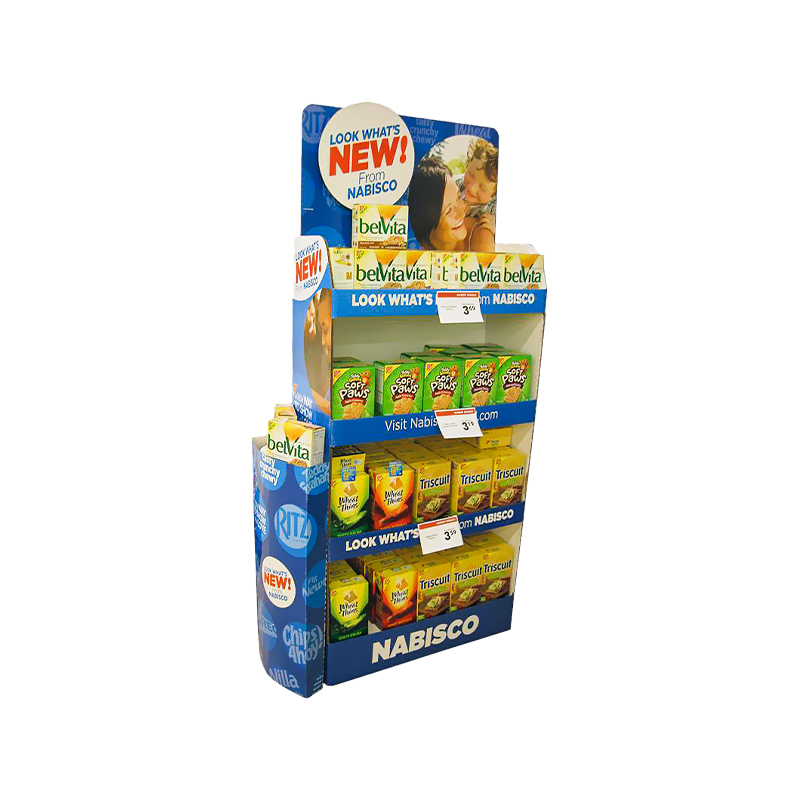-
 +86-0557-3781111 / +86-0571-56396277
+86-0557-3781111 / +86-0571-56396277
 +86-0557-3781111 / +86-0571-56396277
+86-0557-3781111 / +86-0571-56396277
Ensuring the structural integrity of a food display stand , especially for larger or taller designs, is critical to prevent collapse, ensure safety, and maintain functionality. For paper-based food display stands , this becomes even more important due to the inherent limitations of paper materials in terms of strength and load-bearing capacity. Below are detailed strategies and considerations used to ensure structural integrity:
Material Selection
High-Strength Paper :
Use durable materials such as corrugated cardboard , which has a layered structure that provides excellent strength-to-weight ratio. The fluting (wavy inner layer) adds rigidity and resistance to bending.
Kraft paper or coated paperboard may also be used for added durability and moisture resistance.
Coatings and Treatments :
Apply water-resistant coatings (e.g., wax, polyethylene, or biodegradable alternatives) to prevent weakening due to moisture exposure.
Use lamination or varnishing to enhance surface strength and protect against wear and tear.
Structural Design
Reinforced Geometry :
Incorporate triangular supports or angled folds in the design. Triangles are inherently strong shapes that distribute weight evenly and reduce stress on weak points.
Use interlocking panels or tabs to create a self-supporting structure without relying solely on adhesives.
Base Stability :
Ensure the base of the stand is wide and sturdy to provide a stable foundation. A broader base reduces the risk of tipping, especially for taller designs.
Add weight-enhancing elements (e.g., a heavier bottom layer or inserts) to lower the center of gravity.
Load Distribution :
Design shelves or compartments with evenly distributed weight-bearing zones to prevent localized stress points.
Avoid overloading any single section by clearly specifying weight limits for each shelf or compartment.
Layering and Thickness
Multi-Layer Construction :
Use multi-ply layers of paper or cardboard to increase thickness and rigidity. For example, double or triple-wall corrugated cardboard can handle heavier loads.
Combine different materials (e.g., a paper outer layer with a rigid internal frame) for enhanced strength.
Strategic Placement of Layers :
Place thicker or reinforced layers at critical stress points, such as corners, edges, and joints, where structural failure is most likely to occur.
Assembly Techniques
Adhesives :
Use high-strength, eco-friendly adhesives (e.g., water-based glues or biodegradable bonding agents) to securely join components without compromising recyclability.
Ensure proper curing time for adhesives to maximize bond strength.
Mechanical Fasteners :
Incorporate slots, tabs, or interlocking mechanisms that allow parts to fit together snugly without relying solely on glue.
For reusable stands, consider using biodegradable screws or clips to reinforce connections.
Modular Design
Stackable Components :
Design the stand in modular sections that can be stacked or assembled incrementally. This allows users to adjust the height based on their needs while maintaining stability.
Ensure modular components lock securely into place to prevent shifting or wobbling.
Interchangeable Parts :
Include interchangeable shelves or dividers that can be repositioned to accommodate different types of food items while maintaining balance and structural integrity.

Testing and Prototyping
Load Testing :
Conduct rigorous load testing to determine the maximum weight the stand can support without deformation or collapse. Test under both static and dynamic conditions.
Simulate real-world scenarios, such as uneven loading or accidental impacts, to identify potential weak points.
Stability Testing :
Perform tipping tests to evaluate the stand’s resistance to lateral forces, especially for taller designs. Adjust the base width or add stabilizers if necessary.
Durability Testing :
Expose prototypes to environmental factors like humidity, temperature changes, and repeated handling to assess long-term performance.
Reinforcement Features
Internal Framework :
Integrate an internal skeleton made of lightweight but strong materials (e.g., recycled plastic ribs or bamboo supports) to reinforce the structure without significantly increasing weight.
Corner Guards :
Add corner reinforcements or protective caps to high-stress areas like edges and joints to prevent tearing or crushing.
Bracing :
Use cross-bracing or diagonal supports within the design to improve rigidity and prevent swaying in taller stands.
Customization for Specific Needs
Height Limitations :
Set clear guidelines for maximum height based on material strength and intended use. For very tall designs, consider splitting the stand into multiple smaller units stacked securely.
Weight Limits :
Clearly label weight limits for each shelf or compartment to guide users in safely loading the stand.
Application-Specific Adjustments :
For displays holding heavier items (e.g., canned goods), incorporate additional reinforcements or limit the number of tiers.
Sustainability Considerations
Recyclability :
Ensure all reinforcement techniques (e.g., coatings, adhesives) are compatible with recycling processes to maintain the eco-friendly appeal of the stand.
Biodegradability :
Use biodegradable reinforcements or additives that break down naturally after disposal.
Customer Instructions
Assembly Guidelines :
Provide clear instructions for assembly, emphasizing the importance of following the design to ensure stability.
Usage Recommendations :
Educate users on proper loading practices (e.g., heavier items on lower shelves) to prevent overburdening the structure.
Annhiu Address: Yishan Road and Qingshengou Road Intersection, Suzhou Economic Development Zone, Anhui, China
Tel: +86-0557-3781111
E-mail: [email protected]
Hangzhou Address: Building 3, No.286, Renliang Road, Renhe Street, Yuhang District, Hangzhou, Zhejiang, China
Tel: +86-0571-56396277
E-mail: [email protected]
Copyright © Hangzhou Shengpin Packaging Co., Ltd. All Rights Reserved.
